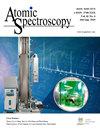利用NanoSIMS 50L高空间分辨率测量橄榄石中含水量
IF 2.3
2区 化学
Q1 SPECTROSCOPY
引用次数: 2
摘要
:橄榄石是行星地幔中最丰富的矿物。它的含水量对行星内部的过程和动力学提供了关键的约束。橄榄石通常形成典型宽度为5–20μm的区域,这需要高空间分辨率。对于二次离子质谱(SIMS)测量,利用具有低电流的初级束来实现高空间分辨率。然而,这种策略也导致了高背景,不能应用于名义上无水的矿物,例如橄榄石。因此,在低背景下实现高空间分辨率是必要的,但具有挑战性。例如,即使NanoSIMS是为高空间分辨率测量而设计的,但为了保持<10ppm的低水背景,含水量分析的空间分辨率仍保持在>10μm。在本研究中,我们使用CAMECA NanoSIMS 50L优化了橄榄石含水量分析的主光束设置和光栅尺寸,以同时提高空间分辨率和背景。测量含水量在11.2ppm至70.6ppm范围内的橄榄石标准样品(KLB-1、ICH-30、Mongok),以进行1H-/16O-比的含水量校准。ppm用于背景监测。结果表明,通过施加2 nA的Cs+束流,直径约为2μm,光栅面积为4×4μm2,可以获得背景为6±2ppm的空间分辨率约为6μm(主束尺寸+光栅尺寸)。对于含水量>10ppm的标准样品,该方法的分析再现性优于13%。总体而言,该方法将测量含水量的空间分辨率提高了约2倍(与之前的研究相比),并可应用于具有复杂分区的橄榄石颗粒。本文章由计算机程序翻译,如有差异,请以英文原文为准。
High-Spatial-Resolution Measurement Of Water Content In Olivine Using NanoSIMS 50L
: Olivine is the most abundant mineral in the planetary mantle. Its water content provides critical constraints on the processes and dynamics of the planetary interior. Olivine usually develops zonings with typical widths of 5–20 μm, which requires high spatial resolution. For secondary ion mass spectrometry (SIMS) measurements, primary beams with low currents were utilized to achieve high spatial resolution. However, this strategy also resulted in high background, which cannot be applied to nominally anhydrous minerals, e.g., olivine. Therefore, achieving high spatial resolution with low background is essential but challenging. For example, even though the NanoSIMS is designed for high-spatial-resolution measurements, the spatial resolution remained at > 10 μm for water content analysis in order to maintain a low water background of < 10 ppm. In this study, we optimized the primary beam settings and raster size for water content analysis of olivine using a CAMECA NanoSIMS 50L to improve the spatial resolution and the background simultaneously. Olivine standard samples (KLB-1, ICH-30, Mongok) with a water content ranging from 11.2 ppm to 70.6 ppm were measured for water content calibration with 1 H - / 16 O - ratio. ppm was used for background monitoring. The results showed that a spatial resolution of ~6 μm (primary beam size + raster size) with a background of 6 ± 2 ppm could be achieved by applying a Cs + beam current of 2 nA with a diameter of ~2 μm, rastering an area of 4 × 4 μm 2 . The analytical reproducibility of this method is better than 13% for standard samples with a water content of > 10 ppm. Overall, this method improved the spatial resolution for measuring water content by a factor of ~2 (in comparison to previous studies) and could be applied to olivine grains with complex zoning.
求助全文
通过发布文献求助,成功后即可免费获取论文全文。
去求助
来源期刊

Atomic Spectroscopy
物理-光谱学
CiteScore
5.30
自引率
14.70%
发文量
42
审稿时长
4.5 months
期刊介绍:
The ATOMIC SPECTROSCOPY is a peer-reviewed international journal started in 1962 by Dr. Walter Slavin and now is published by Atomic Spectroscopy Press Limited (ASPL). It is intended for the rapid publication of both original articles and review articles in the fields of AAS, AFS, ICP-OES, ICP-MS, GD-MS, TIMS, SIMS, AMS, LIBS, XRF and related techniques. Manuscripts dealing with (i) instrumentation & fundamentals, (ii) methodology development & applications, and (iii) standard reference materials (SRMs) development can be submitted for publication.
 求助内容:
求助内容: 应助结果提醒方式:
应助结果提醒方式:


